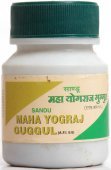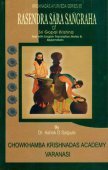Bhagandara, Bhagamdara: 15 definitions
Introduction:
Bhagandara means something in Hinduism, Sanskrit, Marathi, Jainism, Prakrit. If you want to know the exact meaning, history, etymology or English translation of this term then check out the descriptions on this page. Add your comment or reference to a book if you want to contribute to this summary article.
In Hinduism
Ayurveda (science of life)
Kalpa (Formulas, Drug prescriptions and other Medicinal preparations)
Source: Ancient Science of Life: Yogaśataka of Pandita VararuciBhagandara (भगन्दर) refers to “fissure in ano”, and is mentioned in the 10th century Yogaśataka written by Pandita Vararuci.—The Yogaśataka of Pandita Vararuci is an example of this category. This book attracts reader by its very easy language and formulations which can be easily prepared and have small number of herbs. It describes only those formulations which are the most common and can be used in majority conditions of diseases (viz., Bhagandara).
Kṣāra taila prepared from Kṣāra (caustic alkali) of Muṣkaka (Schrebera swietenioides Roxb.), Nalaśikhā and Śaṅkha is prescribed for healing of wounds, Bhagandara (fissure in ano), Nāḍivraṇa (fistula) and skin and throat diseases.
Source: Shodhganga: Edition translation and critical study of yogasarasamgrahaBhagandara (भगन्दर) refers to “fistula-in-ano” and is one of the various diseases mentioned in the 15th-century Yogasārasaṅgraha (Yogasara-saṅgraha) by Vāsudeva: an unpublished Keralite work representing an Ayurvedic compendium of medicinal recipes. The Yogasārasaṃgraha [mentioning bhagandara] deals with entire recipes in the route of administration, and thus deals with the knowledge of pharmacy (bhaiṣajya-kalpanā) which is a branch of pharmacology (dravyaguṇa).
Unclassified Ayurveda definitions
Source: Wisdom Library: Āyurveda and botanyBhagandara (भगन्दर) is a Sanskrit technical term, translating to “fistula-in-ano”. The term is used throughout Ayurvedic literature such as the Suśruta-saṃhitā and the Caraka-saṃhitā.
Source: PMC: Management of rare, low anal anterior fistula exception to Goodsall's rule with KṣārasūtraAnal fistula (bhagandara) is a chronic inflammatory condition, a tubular structure opening in the ano-rectal canal at one end and surface of perineum/peri-anal skin on the other end. Typically, fistula has two openings, one internal and other external associated with chronic on/off pus discharge on/off pain, pruritis and sometimes passing of stool from external opening.
Suśruta saṃhitā elaborately describes bhagandara (anal fistula). The condition is termed bhagandara as it does dāraṇā (tearing) of bhaga (perineum), guda (rectum) and basti pradeśa (pelvis). Bhagadara is enlisted among aṣṭamahāgada (eight intricate diseases) which by nature are difficult to cure considering the morbidity, reoccurrence and social burden. The causative factors are attributed to the doṣa viz., vāta, pitta, śleṣma, sannipāta and the external factors such as trauma, infection etc., (āgantuja).
Source: PMC: Wound healing potential of Pañcavalkala formulations in a postfistulectomy woundSuśruta has described Bhagandara (भगन्दर, fistula-in-ano) as one of the aṣṭamahagadas (eight major diseases) due to its recurrent nature. It is clearly mentioned in Suśruta Saṃhitā that Bhagandara can be treated with chedana (i.e., fistulectomy: Excision of the fistulous tract) or kṣārasūtra in case of debilitated, weak, child or female patients.
Source: PMC: Management of Ano-Rectal disorders by KṣārasūtraĀcārya Suśruta has elaborately described about Bhagandara (fistula-in-ano), its pathogenesis two stages of disease formation as Bhagandara pīḍaka (peri-anal abscess) and Bhagandara (fistula-in-ano), along with remedial surgical procedures. Fistula-in-ano implies a chronic granulating track connecting two epithelial lined surfaces. This may be cutaneous or mucosal.
Source: Research Gate: Internal applications of Vatsanabha (Aconitum ferox wall)Bhagandara (भगन्दर) refers to “fistula-in-ano” (an abnormal tract or cavity with an external opening in the perianal area). Vatsanābha (Aconitum ferox), although categorized as sthāvara-viṣa (vegetable poisons), has been extensively used in ayurvedic pharmacopoeia.
Source: Ancient Science of Life: Vaidyavallabha: An Authoritative Work on Ayurveda TherapeuticsBhagandara (भगन्दर) refers to “fistula in ano”, and is dealt with in the 17th-century Vaidyavallabha written by Hastiruci.—The Vaidyavallabha is a work which deals with the treatment and useful for all 8 branches of Ayurveda. The text Vaidyavallabha has been designed based on the need (viz., bhagandara) of the period of the author, availability of drugs during that time, disease manifesting in that era, socio-economical-cultural-familial-spiritual-aspects of that period Vaidyavallabha.

Āyurveda (आयुर्वेद, ayurveda) is a branch of Indian science dealing with medicine, herbalism, taxology, anatomy, surgery, alchemy and related topics. Traditional practice of Āyurveda in ancient India dates back to at least the first millenium BC. Literature is commonly written in Sanskrit using various poetic metres.
Purana and Itihasa (epic history)
Source: Wisdom Library: Viṣṇu-purāṇaBhagandara (भगन्दर) refers to “fistula” (an abnormal connection between two hollow spaces) and represents a type of Ādhyātmika pain of the bodily (śārīra) type, according to the Viṣṇu-purāṇa 6.5.1-6. Accordingly, “the wise man having investigated the three kinds of worldly pain, or mental and bodily affliction and the like, and having acquired true wisdom, and detachment from human objects, obtains final dissolution.”
Ādhyātmika and its subdivisions (e.g., bhagandara) represents one of the three types of worldly pain (the other two being ādhibhautika and ādhidaivika) and correspond to three kinds of affliction described in the Sāṃkhyakārikā.
The Viṣṇupurāṇa is one of the eighteen Mahāpurāṇas which, according to tradition was composed of over 23,000 metrical verses dating from at least the 1st-millennium BCE. There are six chapters (aṃśas) containing typical puranic literature but the contents primarily revolve around Viṣṇu and his avatars.

The Purana (पुराण, purāṇas) refers to Sanskrit literature preserving ancient India’s vast cultural history, including historical legends, religious ceremonies, various arts and sciences. The eighteen mahapuranas total over 400,000 shlokas (metrical couplets) and date to at least several centuries BCE.
Languages of India and abroad
Marathi-English dictionary
Source: DDSA: The Molesworth Marathi and English Dictionarybhagandara (भगंदर).—m (S) A disease in which fistulas and ulcerous holes form in the anus and private parts. It is distinguished into eight varieties, viz. arśasa, unmārgī, uṣṭragrīva or uṣṭraśirōdhara, ṛju, pariśrāvī, parikṣēpī, śatapōnaka, śambūkāvartta.
Marathi is an Indo-European language having over 70 million native speakers people in (predominantly) Maharashtra India. Marathi, like many other Indo-Aryan languages, evolved from early forms of Prakrit, which itself is a subset of Sanskrit, one of the most ancient languages of the world.
Sanskrit dictionary
Source: Cologne Digital Sanskrit Dictionaries: Shabda-Sagara Sanskrit-English DictionaryBhagandara (भगन्दर).—m.
(-raḥ) Fistula in ano. E. bhaga the vulva, dṛ to divide, aff. khaś .
Source: Cologne Digital Sanskrit Dictionaries: Yates Sanskrit-English DictionaryBhagandara (भगन्दर):—[bhaga-ndara] (raḥ) 1. m. Fistula in ano.
Source: DDSA: Paia-sadda-mahannavo; a comprehensive Prakrit Hindi dictionary (S)Bhagandara (भगन्दर) in the Sanskrit language is related to the Prakrit word: Bhagaṃdara.
Sanskrit, also spelled संस्कृतम् (saṃskṛtam), is an ancient language of India commonly seen as the grandmother of the Indo-European language family (even English!). Closely allied with Prakrit and Pali, Sanskrit is more exhaustive in both grammar and terms and has the most extensive collection of literature in the world, greatly surpassing its sister-languages Greek and Latin.
Prakrit-English dictionary
Source: DDSA: Paia-sadda-mahannavo; a comprehensive Prakrit Hindi dictionaryBhagaṃdara (भगंदर) in the Prakrit language is related to the Sanskrit word: Bhagandara.
Prakrit is an ancient language closely associated with both Pali and Sanskrit. Jain literature is often composed in this language or sub-dialects, such as the Agamas and their commentaries which are written in Ardhamagadhi and Maharashtri Prakrit. The earliest extant texts can be dated to as early as the 4th century BCE although core portions might be older.
Kannada-English dictionary
Source: Alar: Kannada-English corpusBhagaṃdara (ಭಗಂದರ):—[noun] a disease characterised by jagged or lacerate vulva.
Kannada is a Dravidian language (as opposed to the Indo-European language family) mainly spoken in the southwestern region of India.
See also (Relevant definitions)
Partial matches: Bhaga.
Full-text: Bhagamdara, Parisravin, Ashtamaharoga, Maharoga, Bhagendra, Bhagadarana, Jaigishavya, Bhagandar, Parikshepin, Shambukavarta, Bhagandala, Ushtragriva, Kshataja, Nadivrana, Paracina, Dara.
Relevant text
Search found 15 books and stories containing Bhagandara, Bhaga-ndara, Bhagamdara, Bhagaṃdara; (plurals include: Bhagandaras, ndaras, Bhagamdaras, Bhagaṃdaras). You can also click to the full overview containing English textual excerpts. Below are direct links for the most relevant articles:
Atharvaveda and Charaka Samhita (by Laxmi Maji)
Treatment of Bhagandara (fistula in the anus) < [Chapter 3 - Diseases and Remedial measures (described in Atharvaveda)]
Mādhavanidāna (Āyurveda book) < [Chapter 1 - Introduction]
Rasendrasāra Saṅgraha (Āyurveda book) < [Chapter 1 - Introduction]
Jivanandana of Anandaraya Makhin (Study) (by G. D. Jayalakshmi)
The diseases of the Mulādhāra < [Chapter 4 - Āyurvedic principles in Jīvanandana Nāṭaka]
Medicines administered for different diseases < [Chapter 4 - Āyurvedic principles in Jīvanandana Nāṭaka]
Āyurvedic aspects of Act I < [Chapter 4 - Āyurvedic principles in Jīvanandana Nāṭaka]
The Garuda Purana (by Manmatha Nath Dutt)
Chapter CLXXX - The Nidanam of Fistual in Anas, etc. < [Dhanvantari Samhita]
Sushruta Samhita, volume 2: Nidanasthana (by Kaviraj Kunja Lal Bhishagratna)
Sushruta Samhita, volume 4: Cikitsasthana (by Kaviraj Kunja Lal Bhishagratna)
Bhagavatpadabhyudaya by Lakshmana Suri (study) (by Lathika M. P.)
Śaṅkara affected by the disease Bhagandara < [Chapter 4 - Similarities and Dissimilarities]
Related products




